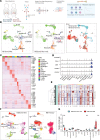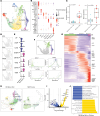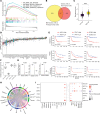Single-cell analyses of metastatic bone marrow in human neuroblastoma reveals microenvironmental remodeling and metastatic signature
- PMID: 38358826
- PMCID: PMC10972621
- DOI: 10.1172/jci.insight.173337
Single-cell analyses of metastatic bone marrow in human neuroblastoma reveals microenvironmental remodeling and metastatic signature
Abstract
Neuroblastoma is an aggressive pediatric cancer with a high rate of metastasis to the BM. Despite intensive treatments including high-dose chemotherapy, the overall survival rate for children with metastatic neuroblastoma remains dismal. Understanding the cellular and molecular mechanisms of the metastatic tumor microenvironment is crucial for developing new therapies and improving clinical outcomes. Here, we used single-cell RNA-Seq to characterize immune and tumor cell alterations in neuroblastoma BM metastases by comparative analysis with patients without metastases. Our results reveal remodeling of the immune cell populations and reprogramming of gene expression profiles in the metastatic niche. In particular, within the BM metastatic niche, we observed the enrichment of immune cells, including tumor-associated neutrophils, macrophages, and exhausted T cells, as well as an increased number of Tregs and a decreased number of B cells. Furthermore, we highlighted cell communication between tumor cells and immune cell populations, and we identified prognostic markers in malignant cells that are associated with worse clinical outcomes in 3 independent neuroblastoma cohorts. Our results provide insight into the cellular, compositional, and transcriptional shifts underlying neuroblastoma BM metastases that contribute to the development of new therapeutic strategies.
Keywords: Bone biology; Bone marrow; Cancer; Oncology.
Figures





References
Publication types
MeSH terms
LinkOut - more resources
Full Text Sources
Medical
Molecular Biology Databases
Research Materials

